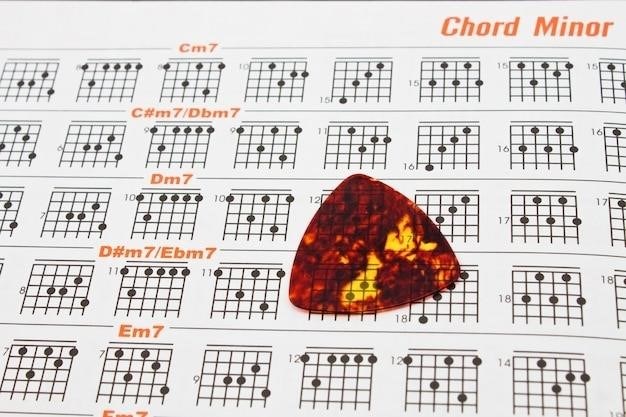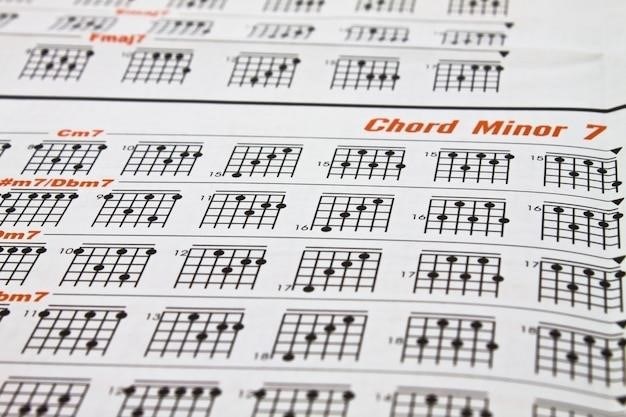Essential Jazz Guitar Chords⁚ A Comprehensive Guide
This guide explores essential jazz guitar chords, encompassing various voicings, from basic triads to seventh chords and extensions․ Discover resources like PDFs and online courses for further learning and practice․ Master essential progressions and comping techniques to enhance your jazz guitar skills․
Introduction to Jazz Guitar Chords
Embark on a journey into the captivating world of jazz guitar chords! This comprehensive guide unveils the foundational elements of jazz harmony, equipping you with the knowledge to navigate the rich landscape of jazz guitar․ We’ll explore the fundamental building blocks of jazz chords, including major, minor, dominant, and diminished triads, laying the groundwork for more advanced chord voicings․ Understanding these basic chord types is crucial for comprehending more complex jazz harmonies and improvisational techniques․ We will delve into the intricacies of seventh chords and their extensions, unlocking the secrets to creating sophisticated and nuanced chord progressions․ Prepare to unlock the potential of your guitar and express yourself through the vibrant language of jazz․
Numerous resources are available online, including downloadable PDFs and interactive online courses․ These resources offer a wealth of information and exercises to aid your learning process․ Whether you’re a beginner or an experienced guitarist, this guide is designed to enhance your understanding and proficiency in jazz guitar chords․ Get ready to transform your guitar playing with the rich and expressive vocabulary of jazz harmony․ Begin your journey towards mastering the art of jazz guitar today!
Common Chord Voicings⁚ Drop 2 and Drop 3
Delve into the realm of Drop 2 and Drop 3 voicings, two fundamental techniques employed by countless jazz guitar masters․ These voicings, characterized by their smooth and flowing sound, are highly versatile, seamlessly integrating into both comping and soloing contexts․ Drop 2 involves moving the seventh of a seventh chord down an octave, creating a smoother, more connected sound․ The Drop 3 voicing, similarly, shifts the third of a seventh chord down an octave, offering a unique textural quality․ Mastering these techniques allows for effortless transitions between chords, contributing to a fluid and expressive playing style․
Understanding the nuances of Drop 2 and Drop 3 voicings is key to unlocking the stylistic essence of many jazz guitar greats, including Wes Montgomery and Joe Pass․ These voicings are not merely technical exercises; they are expressive tools that shape the emotional landscape of your playing․ Explore variations and experiment with different inversions to discover the unique voice each voicing offers․ With practice, you’ll find yourself effortlessly weaving these techniques into your playing, enhancing your improvisational capabilities and overall musicality․ Numerous online resources, including PDFs and video tutorials, can guide you in mastering these essential voicings․
Understanding Intervals and Triads in Jazz
Grasping intervals and triads is paramount to comprehending jazz harmony․ Intervals, the distance between two notes, form the building blocks of chords․ Understanding major, minor, perfect, augmented, and diminished intervals is crucial for recognizing chord qualities and creating sophisticated voicings․ Triads, three-note chords built from a root, third, and fifth, are the foundation of most jazz harmonies․ Major triads sound bright and uplifting, while minor triads evoke a darker, more melancholic feel․ Augmented and diminished triads introduce more complex harmonic colors, often used for creating tension and resolution․
The ability to quickly identify intervals and triad types within a chord progression is a skill that develops with practice and aural training․ Learning to hear these relationships will greatly enhance your improvisational abilities and your overall understanding of jazz harmony․ Many resources, including well-structured PDFs and online courses, offer exercises to improve your interval recognition and triad identification skills․ By thoroughly understanding intervals and triads, you’ll develop a strong foundation for more advanced harmonic concepts, such as seventh chords and extensions, allowing you to explore the rich harmonic language of jazz with confidence and creativity․

Seventh Chords and Extensions
Seventh chords, adding a seventh interval to a triad, are fundamental to jazz harmony․ They introduce a richer, more complex sound compared to basic triads․ Major seventh chords (maj7) sound bright and joyful, while minor seventh chords (min7) are darker and more introspective․ Dominant seventh chords (7) create tension and often resolve to a tonic chord, driving the harmonic progression forward․ Half-diminished (ø7) and diminished (o7) seventh chords add unique colors, often used for chromatic movement and substitutions․
Extensions, adding notes beyond the seventh, further enrich jazz chords․ Ninth, eleventh, and thirteenth chords add complexity and sophistication․ These extensions are often altered, creating unique sounds and colors․ Understanding how extensions function within a chord progression is essential for crafting sophisticated voicings․ Many resources, including numerous PDFs and online courses, offer detailed explanations and diagrams of seventh chords and their extensions․ These resources often include exercises and examples that help you apply this knowledge to your playing․ By mastering seventh chords and extensions, you’ll be well-equipped to navigate the complex harmonic landscape of jazz guitar;
Exploring Quartal Chords and Sus Chords

Quartal chords, built in fourths instead of thirds, offer a unique, often dissonant sound in jazz guitar․ Unlike traditional tertian harmony, quartal voicings create a more open and spacious texture․ They are frequently used to create harmonic interest and avoid predictable progressions․ Common quartal structures include stacking perfect fourths, creating a unique harmonic color that contrasts with the more traditional tertian approach․ Many jazz guitarists employ quartal chords strategically to add a modern, sophisticated feel to their improvisations and comping․
Suspended chords (sus chords), characterized by a suspended fourth or second in place of the third, introduce a sense of anticipation and resolution․ Sus4 chords create a feeling of tension that resolves satisfyingly to a major chord․ Sus2 chords, less common but equally effective, add a more delicate and mysterious flavor․ These chords are frequently used to add rhythmic and harmonic interest to a jazz progression, often appearing as passing chords or resolving to the underlying chord․ Exploring these voicings will greatly enhance your jazz guitar vocabulary, allowing for greater harmonic complexity and creativity in your playing․ Various resources, including PDFs and online courses, delve into the intricacies of quartal and sus chords, providing exercises and examples for practical application․
The Freddie Green Style and Comping Rhythms
Freddie Green, Count Basie’s legendary rhythm guitarist, developed a unique comping style that profoundly influenced jazz guitar․ His approach prioritized rhythmic precision and understated elegance over flashy solos․ Green’s style often involved playing single-note lines on the lower strings, emphasizing the root and other crucial bass notes of the chord․ This created a solid, driving rhythmic foundation for the ensemble․ His rhythmic approach, characterized by a steady pulse and subtle variations in articulation, is a cornerstone of swing-era jazz guitar․
Many guitarists emulate Green’s style by employing a combination of single-note lines, arpeggios, and chordal fragments․ The emphasis remains on rhythmic precision and a strong sense of groove․ Effective comping involves listening attentively to the other musicians and responding accordingly․ This includes anticipating changes in harmony and rhythm, and providing a supportive harmonic foundation․ Understanding Green’s approach unlocks a wealth of rhythmic possibilities, transforming your comping from a mere accompaniment to an integral part of the musical conversation․ Numerous resources, such as instructional PDFs and online tutorials, dissect Green’s techniques and provide exercises for developing this rhythmic mastery․
Bossa Nova Chord Styles and Applications
Bossa nova, a genre born in Brazil, infuses jazz harmony with a uniquely relaxed and sophisticated feel․ Its characteristic chord voicings often feature added 6ths and 9ths, creating a rich and colorful harmonic texture․ These additions subtly alter the basic chord qualities, adding a touch of sweetness and sophistication․ The rhythmic feel is typically laid-back and flowing, characterized by a gentle swing and subtle syncopation․ Common chord progressions in bossa nova often feature ii-V-I progressions, but with characteristic alterations and extensions․
Guitarists often employ open voicings and arpeggiated figures to capture the genre’s breezy feel․ The use of walking bass lines is also common, providing a melodic and rhythmic counterpoint to the chords․ Many bossa nova tunes feature a light and airy touch, with plenty of space between notes․ This allows for melodic improvisation and creates a sense of openness and airiness․ Mastering bossa nova chord styles involves not just understanding the harmonic alterations, but also internalizing the rhythmic feel and stylistic nuances․ Numerous resources, including instructional PDFs and online courses, delve into the intricacies of bossa nova guitar techniques․
Chord Melody and Soloing Techniques
Chord melody playing, a cornerstone of jazz guitar, involves simultaneously playing a melody and the underlying chord voicings․ This technique requires a deep understanding of harmony and voice leading, allowing for rich and expressive musical lines․ Effective chord melody necessitates skillful fingerpicking or hybrid picking techniques to articulate both melody and harmony clearly․ Various voicings, including drop 2 and drop 3 voicings, are commonly employed to achieve smooth transitions and create interesting textural contrasts․
Soloing over chord progressions is another crucial aspect․ Jazz guitar soloing often involves improvisation based on scales, modes, and arpeggios associated with the underlying chords․ Players frequently employ techniques such as passing tones, chromatic approaches, and altered dominant chords to add color and interest to their solos․ Understanding the function of each chord within a progression is key to crafting compelling and logical solos․ Developing a strong sense of rhythm and phrasing is essential for delivering expressive and swinging solos․ Resources like instructional PDFs and online courses offer detailed guidance on chord melody and soloing techniques․
II-V-I Progressions and Chord Voicings
The II-V-I progression, a fundamental building block in jazz harmony, consists of a minor 7th chord (ii), a dominant 7th chord (V), and a major 7th chord (I)․ This sequence creates a strong sense of harmonic motion and resolution․ Numerous voicings exist for each chord within the II-V-I progression, allowing for diverse tonal colors and textures․ Common voicings include drop 2 and drop 3 voicings, which facilitate smooth voice leading and create a more sophisticated sound than simple rootless voicings․ The choice of voicing often depends on the overall context of the musical phrase and the desired melodic contour․
Mastering the II-V-I progression involves understanding the relationship between the chords and how they function within a key․ It’s crucial to be able to play the progression in various inversions and to smoothly transition between different voicings․ Many jazz guitar resources, including PDFs and online courses, provide exercises and examples to help players develop their understanding and proficiency with II-V-I progressions․ Practicing these progressions in different keys and tempos is essential to build fluency and musicality․
Resources and Further Learning⁚ PDFs and Online Courses
Numerous resources are available for those seeking to deepen their understanding of jazz guitar chords․ Many websites offer free downloadable PDFs containing chord charts, diagrams, and exercises․ These PDFs often categorize chords by type (major 7th, minor 7th, dominant 7th, etc․), providing clear visual representations and fingerings for various voicings․ Some PDFs include explanations of chord theory, helping players grasp the underlying harmonic principles․ Additionally, numerous online courses cater specifically to jazz guitarists, providing structured lessons, video tutorials, and interactive exercises․ These courses cover various topics, from basic chord voicings to advanced techniques like comping and soloing․
These online platforms often feature experienced jazz guitar instructors who provide personalized feedback and guidance․ Many courses incorporate practice tracks and play-along exercises, enhancing the learning experience․ Whether you prefer the convenience of a downloadable PDF or the interactive nature of an online course, numerous resources are available to assist in mastering jazz guitar chords․ Supplementing self-study with the guidance of experienced instructors can accelerate progress and help players develop a strong foundation in jazz guitar technique and theory․